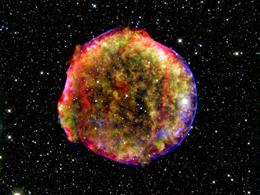 The remnant of Brahe's supernova. The image combines infrared and x-ray data.Max Planck Institute for Astronomy
The remnant of Brahe's supernova. The image combines infrared and x-ray data.Max Planck Institute for AstronomyA team of astronomers has managed to re-watch the explosion of a star that died more than 400 years ago by studying light that has bounced off distant clouds of interstellar dust. Their astronomical archaeology could provide clues about dark energy, a mysterious force that may be pushing the Universe apart.
In November 1572, the Danish astronomer Tycho Brahe spotted something strange in the night sky. "I noticed that a new and unusual star, surpassing the other stars in brilliancy, was shining almost directly above my head," he wrote.
Brahe called the object a "stella nova", or new star, but it was actually the explosive death of an old star, known today as a supernova. The supernova has faded considerably since Brahe's time, but researchers have managed to spot some light from the early days of the explosion. Their work is published in Nature1.
"What we have essentially done here is to use interstellar dust as a kind of a mirror," says Oliver Krause, an astronomer at the Max Planck Institute for Astronomy in Heidelberg, Germany.
When the star burst, it radiated light in all directions. Brahe and others at the time saw the light that came directly towards our planet, but light travelling in other directions is often reflected off clouds of interstellar dust. Because light travels at a finite speed, dust clouds hundreds of light years away from the supernova's origin <a href='http://www.nature.com/nature/newsvideo/lightechoesmedium.mov'>create an "echo"</a> that can still be seen on Earth today.
Stellar apparition
Astronomers have captured light echoes from supernova before, but that from Brahe's blast is the oldest ever seen in the Milky Way. Krause and his colleagues spotted the echo using the massive 8.2-metre Subaru Telescope atop Mauna Kea in Hawaii. They were able to match the faint afterglow to the original blast by looking at the light's spectrum and location in the sky. "It was very exciting when we looked on our screen and saw the spectrum of Brahe's supernova appearing," Krause says.
ADVERTISEMENT
Their observations confirm that the supernova is of a variety known as 'type 1a'. These supernovae are created by the explosion of small, dense stars called white dwarfs. They are believed to explode with a standard brightness, which makes them a good tool for gauging the distance to far-off galaxies.
In recent years, such measurements have revealed that type 1a supernovae are farther away than expected, leading researchers to propose that a mysterious force called "dark energy" is pushing galaxies away from one another. Because Brahe's supernova is in the Milky Way, studying its remains could help astronomers to better understand type 1a supernovae and dark energy itself.
"It's a cool technique," says Adam Riess, an astronomer at Johns Hopkins University in Baltimore, Maryland, who hunts for these supernovae throughout the Universe. Riess says that astronomers already suspected that Brahe's supernova was of the type 1a variety, but the clues were circumstantial. This observation puts any doubts to rest: "It is the kind of evidence that really nails it," he says.
